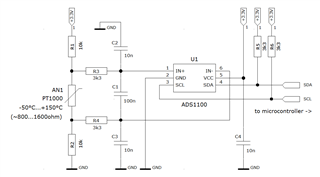Hello,
this has been touched upon earlier couple years ago. We're using ADS1100 to convert PT1000 readings. Settings are default 8 SPS and gain 8 with single conversion. We noticed freezing values which are output from ADS1100. Initially it was recorded in climatic chamber, more recently using a decade box in room temperatures. A range of 10 Ohms results in same value from ADS1100, namely 0x2AAC. This has been recorded by receiving end of i2c without doing any averaging outside ADS1100. Moreover, a similar range, ranging roughly over 5 Ohms, can be found in 0x36DD.
If we change gain to 4, we do not see it happening with half of the output value. However, changing resistance and getting the output to 0x2AAC, it freezes again.
Powering ADS1100 down and up doesn't affect output. Changing to continuous conversion doesn't affect output. Output is stable in general, but on "edges" of this 0x2AAC zone output is erratic inside values of +/- 0x25.



